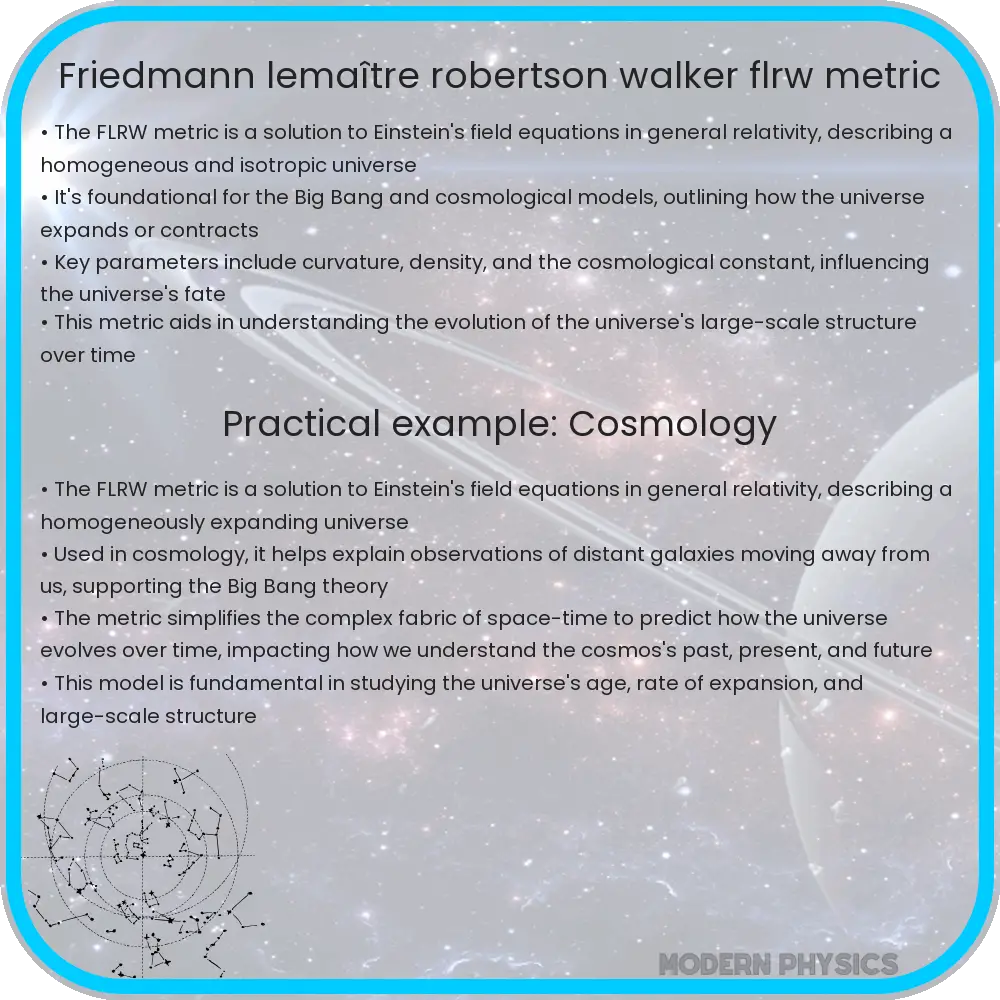Uncover the Friedmann-Lemaître-Robertson-Walker (FLRW) metric, a key solution in general relativity explaining the dynamics and expansion of a homogeneous, isotropic universe.

Understanding the FLRW Metric: A Guide to Universe Dynamics and Cosmology
The Friedmann-Lemaître-Robertson-Walker (FLRW) metric is a solution to Einstein’s field equations in general relativity, specifically formulated for an isotropic and homogeneous universe. This metric defines how distances and time are intertwined on a cosmic scale, playing a crucial role in our understanding of the universe’s dynamics, including its expansion and geometry. Let’s break down the core concepts and equations behind the FLRW metric, making them accessible and understandable.
Basics of the FLRW Metric
The FLRW metric assumes that the universe is homogeneous (the same in all places) and isotropic (the same in all directions). Under these assumptions, the metric simplifies the complex tensor equations of general relativity, focusing on how the structure of space and time is affected by the matter and energy within the universe.
Mathematical Formulation of the FLRW Metric
The metric itself can be written in the following form:
\[ ds^2 = -dt^2 + a(t)^2 \left( \frac{dr^2}{1 – kr^2} + r^2(d\theta^2 + \sin^2\theta d\phi^2) \right) \]
where:
- ds^2 is the square of the differential line element, representing the infinitesimal distance between two events in space-time.
- dt^2 is the square of the differential time element.
- a(t) is the scale factor, which describes how distances within the universe expand or contract over time.
- r, \(\theta\), \(\phi\) are spherical coordinates (radial distance, polar angle, and azimuthal angle, respectively).
- k represents the curvature of space and can take the values of -1, 0, or +1, corresponding to open, flat, and closed universes respectively.
Curvature and Its Implications
The parameter k in the FLRW metric fundamentally alters the geometric fabric of the universe:
- k = 0 indicates a flat universe. Here, the Euclidean geometry rules, and parallel lines do not meet. This is currently the most widely accepted hypothesis based on observations of the cosmic microwave background.
- k = +1 signifies a closed universe with positive curvature. In this model, space is spherically curved, and lines eventually converge.
- k = -1 suggests an open universe with negative curvature, akin to a saddle shape where space curves away from itself at every point.
The curvature parameter k not only describes the present shape of the universe but also influences its ultimate fate. Closed universes can eventually recollapse, flat universes may continue to expand indefinitely at a decelerating rate, and open universes might expand forever, accelerating under certain conditions.
Role of the Scale Factor in Cosmology
The scale factor a(t) within the FLRW metric is a pivotal function in cosmology: it indicates the rate at which the universe expands or contracts over time. It can be derived from observations, such as measuring the redshifts of distant galaxies. The behavior of a(t) over time is dependent on the contents of the universe, such as radiation, matter, dark matter, and dark energy.
Understanding the dynamics of a(t) provides insights into not only the history of the universe, including the Big Bang, but also its future evolution. For instance, a constantly increasing \(a(t)\) points towards an ever-expanding universe, while a complex function might suggest different epochs of expansion and contraction.
In the next section, we will delve deeper into how the FLRW metric applies to the real universe, examining critical phenomena such as the Big Bang and cosmic inflation, and exploring how this metric helps us understand the age, structure, and destiny of our universe through observational evidence.
Application of the FLRW Metric in Cosmological Observations
The FLRW metric not only serves as a theoretical framework in cosmology but also as a practical tool for interpreting astronomical data. By understanding the implications of the FLRW metric, scientists can extrapolate back to the conditions of the early universe and forward to predict its future state.
One of the most notable applications is in the study of the cosmic microwave background (CMB). The CMB is the afterglow of the Big Bang and provides a snapshot of the universe when it was just 380,000 years old. The FLRW metric helps cosmologists understand the CMB’s tiny temperature fluctuations, which reflect density variations in the early universe. These variations are crucial for studying the universe’s large-scale structure formation.
Another significant application involves the observation of distant supernovae. By measuring how their light is redshifted—a phenomenon dictated by the scale factor \( a(t) \)—scientists can infer the rate of the universe’s expansion. This has led to the discovery of the accelerating expansion of the universe, a finding that has profound implications for cosmology and physics, suggesting the presence of dark energy.
Conclusion
The Friedmann-Lemaître-Robertson-Walker metric is more than just a set of equations; it is a fundamental concept that permeates through every aspect of cosmology. By linking time, space, and the material contents of the universe, the FLRW metric provides a comprehensive model that not only describes the universe’s current state but also offers predictions about its future. Whether it’s understanding the cosmic microwave background, studying distant supernovae, or exploring the implications of different curvature parameters, the FLRW metric remains an indispensable tool in the cosmologist’s toolkit.
As we continue to enhance our observational technologies and refine our theoretical models, the FLRW metric will undoubtedly play a crucial role in further unraveling the mysteries of the cosmos. For anyone passionate about understanding the universe, grasping the principles of the FLRW metric is an essential step toward appreciating the grand scale of cosmological phenomena and the underlying laws that govern them.
